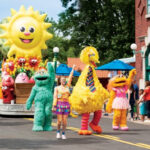Tavern on the Green, located prominently on West 67th Street in New York City’s Central Park, boasts a captivating history intertwined with the evolution of this iconic urban oasis. Originally conceived as a humble sheepfold in the late 19th century, this landmark has transformed through the decades, becoming a world-renowned restaurant that embodies both the charm of its natural setting and the glamour of New York City.
From Sheepfold to Landmark Restaurant
The story of Tavern on the Green begins in the 1880s when Central Park, designed by Frederick Law Olmsted and Calvert Vaux, was already a beloved retreat for city dwellers. Vaux himself designed the structure initially as a sheepfold, a practical building intended to house the 200 Southdown sheep that peacefully grazed in the adjacent Sheep Meadow. This pastoral scene offered a touch of countryside tranquility amidst the burgeoning metropolis.
However, the building’s destiny took a dramatic turn in 1934. Robert Moses, the influential Parks Commissioner, spearheaded a significant renovation of Central Park during the Great Depression. As part of this ambitious project, Moses reimagined the sheepfold as a restaurant. This transformation marked the beginning of Tavern on the Green’s journey into culinary and social prominence. The sheep were relocated to Prospect Park in Brooklyn, paving the way for a new chapter in the building’s history.
Mid-Century Glamour and Expansion
Over the subsequent decades, Tavern on the Green flourished, adapting to changing tastes and expanding its appeal. Under various management teams, the restaurant solidified its reputation as a premier dining and entertainment destination. The allure of its Central Park setting was undeniable, and enhancements like a spacious dance floor and outdoor seating further elevated its appeal. The menu evolved into a lavish offering, attracting a clientele that included prominent actors, musicians, and public figures. Tavern on the Green became synonymous with celebration and sophisticated dining in New York City.
The 1940s and 1950s witnessed significant expansions to the physical space of Tavern on the Green. The dance floor was enlarged to accommodate more guests, and a substantial outdoor patio was added, maximizing enjoyment of the park views. The Elm Tree Room was also constructed during this period, providing additional dining space and contributing to the restaurant’s growing capacity and versatility. Images from this era often depict elegantly dressed patrons enjoying Lobster Newburg, a classic dish reflecting the restaurant’s commitment to fine dining.
The Warner LeRoy Era: Opulence and Spectacle
In 1976, Tavern on the Green entered a new era of extravagance under the ownership of Warner LeRoy, a theatrical restaurateur known for his lavish establishments. LeRoy undertook a dramatic “reincarnation” of Tavern on the Green, transforming it into a spectacle of opulence. The Crystal Room was added, and the interiors were adorned with brass accents, Tiffany-stained glass, and dazzling Baccarat chandeliers. This opulent redesign cemented Tavern on the Green’s status as a celebrity hotspot, where diners could expect to be surrounded by glamour and theatrical flair.
LeRoy’s vision for Tavern on the Green was one of sensory overload and unforgettable experiences. The restaurant became a destination not just for dining but for experiencing a unique atmosphere of theatrical dining. This era, while controversial to some for its departure from the park’s natural aesthetic, undeniably solidified Tavern on the Green’s international fame and its association with New York City’s vibrant social scene.
Rebirth and Return to Tavern Roots in 2014
After a period of closure beginning in 2009, the City of New York embarked on a search for new operators to revitalize Tavern on the Green and restore its place as a beloved landmark. In 2013, Jim Caiola and David Salama, experienced restaurateurs from Philadelphia, were selected to lead this revival. Their vision was to steer Tavern on the Green back to its more inviting, tavern-inspired origins, emphasizing approachability and a connection to its historical roots.
The new owners undertook a significant renovation, opting for a décor that incorporated inviting elements and wood paneling reminiscent of the original sheepfold. This design choice signaled a conscious effort to reconnect Tavern on the Green with its park setting and its initial, more rustic character. Furthermore, Caiola and Salama introduced a seasonal menu that prioritized local and artisanal ingredients, reflective of the rich culinary landscape of Greater New York.
Tavern on the Green reopened in April 2014, presenting a refreshed identity that honored its history while embracing contemporary dining trends. The emphasis on local food and a welcoming atmosphere resonated with both New Yorkers and visitors, reaffirming its position as a cherished destination within Central Park. While live sheep may no longer graze outside its doors, Tavern on the Green continues to offer a unique experience that blends history, culinary artistry, and the enchanting backdrop of one of the world’s most famous parks.
A Cinematic Icon: Tavern on the Green in Film
Beyond its culinary and social significance, Tavern on the Green has also achieved iconic status on the silver screen. Its distinctive ambiance and recognizable Central Park location have made it a popular filming location for numerous movies over the years. Appearing or being mentioned in films reinforces its image as a quintessential New York City landmark, recognizable to audiences worldwide.
Some notable films that have featured Tavern on the Green include:
- An Unmarried Woman (1978)
- It’s My Turn (1980)
- Arthur (1981)
- Only When I Laugh (1981)
- Ghostbusters (1984)
- Heartburn (1986)
- Wall Street (1987)
- Arthur 2: On the Rocks (1988)
- Beaches (1988)
- New York Stories: Oedipus Wrecks (1989)
- Crimes and Misdemeanors (1989)
- Stella (1990)
- Whispers in the Dark (1992)
- The Night We Never Met (1993)
- The Out-of-Towners (1999)
- It Had to be You (2000)
- Hall of Mirrors (2001)
- Made (2001)
- Alfie (2004)
- New York, I Love You (2008)
- Mr. Popper’s Penguins (2011)
This extensive filmography underscores Tavern on the Green’s enduring appeal and its symbolic representation of New York City in popular culture. Its presence in these films further solidifies its place as not just a restaurant, but a cultural landmark deeply embedded in the city’s identity.
Partners in Preservation and Community
Tavern on the Green’s story is also linked to various organizations dedicated to preserving and enhancing Central Park and the surrounding community. These partnerships highlight the restaurant’s integration within the larger context of Central Park and its commitment to civic engagement.
Through its long and multifaceted history, Tavern on the Green at West 67th Street in New York City remains more than just a restaurant. It is a living chronicle of Central Park’s evolution, a symbol of New York City’s dynamic spirit, and a cherished landmark that continues to evolve while preserving its iconic charm.


